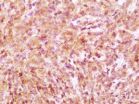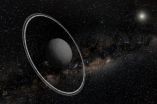(Press-News.org) The animals lived 520 million years ago during the Early Cambrian, a period known as the 'Cambrian Explosion' in which all the major animal groups and complex ecosystems suddenly appeared. Tamisiocaris belongs to a group of animals called anomalocarids, a type of early arthropod that included the largest and some of the most iconic animals of the Cambrian period. They swam using flaps down either side of the body and had large appendages in front of their mouths that they most likely used to capture larger prey, such as trilobites.
However, the newly discovered fossils show that those predators also evolved into suspension feeders, their grasping appendages morphing into a filtering apparatus that could be swept like a net through the water, trapping small crustaceans and other organisms as small as half a millimetre in size.
The evolutionary trend that led from large, apex predators to gentle, suspension-feeding giants during the highly productive Cambrian period is one that has also taken place several other times throughout Earth's history, according to lead author Dr Jakob Vinther, a lecturer in macroevolution at the University of Bristol.
Dr Vinther said: "These primitive arthropods were, ecologically speaking, the sharks and whales of the Cambrian era. In both sharks and whales, some species evolved into suspension feeders and became gigantic, slow-moving animals that in turn fed on the smallest animals in the water."
In order to fully understand how the Tamisiocaris might have fed, the researchers created a 3D computer animation of the feeding appendage to explore the range of movements it could have made.
"Tamisiocaris would have been a sweep net feeder, collecting particles in the fine mesh formed when it curled its appendage up against its mouth," said Dr Martin Stein of the University of Copenhagen, who created the computer animation.
"This is a rare instance when you can actually say something concrete about the feeding ecology of these types of ancient creatures with some confidence."
The discovery also helps highlight just how productive the Cambrian period was, showing how vastly different species of anomalocaridids evolved at that time, and provides further insight into the ecosystems that existed hundreds of millions of years ago.
"The fact that large, free-swimming suspension feeders roamed the oceans tells us a lot about the ecosystem," Dr Vinther said. "Feeding on the smallest particles by filtering them out of the water while actively swimming around requires a lot of energy – and therefore lots of food."
Tamisiocaris is one of many recent discoveries of remarkably diverse anomalocarids found in rocks aged 520 to 480 million years old. "We once thought that anomalocarids were a weird, failed experiment," said co-author Dr Nicholas Longrich at the University of Bath. "Now we're finding that they pulled off a major evolutionary explosion, doing everything from acting as top predators to feeding on tiny plankton."
The Tamisiocaris fossils were discovered during a series of recent expeditions led by co-author David Harper, a professor at Durham University. "The expeditions have unearthed a real treasure trove of new fossils in one of the remotest parts of the planet, and there are many new fossil animals still waiting to be described," he said. "Our new understanding of this remarkable animal adds another piece to a fascinating jigsaw puzzle."
INFORMATION:
The expeditions were funded by the Agouron Institute, Carlsberg Foundation and Geocenter Denmark.
Paper
'A suspension feeding anomalocarid from the early Cambrian' by Jakob Vinther, Martin Stein, Nicholas R. Longrich and David A. T. Harper in Nature DOI: 10.1038/nature13010
Contact
Dr. Jakob Vinther
School of Earth Sciences and School of Biological Sciences, University of Bristol
jakob.vinther@bristol.ac.uk +44 (0)7746 383368
Ancient sea creatures filtered food like modern whales
2014-03-26
ELSE PRESS RELEASES FROM THIS DATE:
First ring system around asteroid
2014-03-26
The rings of Saturn are one of the most spectacular sights in the sky, and less prominent rings have also been found around the other giant planets. Despite many careful searches, no rings had been found around smaller objects orbiting the Sun in the Solar System. Now observations of the distant minor planet [1] (10199) Chariklo [2] as it passed in front of a star have shown that this object too is surrounded by two fine rings.
"We weren't looking for a ring and didn't think small bodies like Chariklo had them at all, so the discovery — and the amazing amountof detail ...
Gut metabolism changes -- not stomach size -- linked to success of vertical sleeve gastrectomy
2014-03-26
CINCINNATI—It's not the size of the stomach that causes weight loss after a specific type of bariatric surgery, but rather a change in the gut metabolism, say researchers from the University of Cincinnati (UC), the University of Gothenburg in Sweden and Cincinnati Children's Hospital Medical Center.
The scientists, publishing their results in the March 26, 2014, advanced online edition of Nature, have found that following vertical sleeve gastrectomy, there is a change in bile acids that bind to a nuclear receptor called FXR. In the absence of FXR, the researchers showed, ...
Some breast cancer tumors hijack patient epigenetic machinery to evade drug therapy
2014-03-26
PITTSBURGH, March 26, 2014 – A breast cancer therapy that blocks estrogen synthesis to activate cancer-killing genes sometimes loses its effectiveness because the cancer takes over epigenetic mechanisms, including permanent DNA modifications in the patient's tumor, once again allowing tumor growth, according to an international team headed by the University of Pittsburgh Cancer Institute (UPCI).
The finding warrants research into adding drugs that could prevent the cancer from hijacking patients' repressive gene regulatory machinery, which might allow the original therapy ...
First comprehensive atlas of human gene activity released
2014-03-26
Boston, MA — A large international consortium of researchers has produced the first comprehensive, detailed map of the way genes work across the major cells and tissues of the human body. The findings describe the complex networks that govern gene activity, and the new information could play a crucial role in identifying the genes involved with disease.
"Now, for the first time, we are able to pinpoint the regions of the genome that can be active in a disease and in normal activity, whether it's in a brain cell, the skin, in blood stem cells or in hair follicles," said ...
Brain degeneration in Huntington's disease caused by amino acid deficiency
2014-03-26
Working with genetically engineered mice, Johns Hopkins neuroscientists report they have identified what they believe is the cause of the vast disintegration of a part of the brain called the corpus striatum in rodents and people with Huntington's disease: loss of the ability to make the amino acid cysteine. They also found that disease progression slowed in mice that were fed a diet rich in cysteine, which is found in foods such as wheat germ and whey protein.
Their results suggest further investigation into cysteine supplementation as a candidate therapeutic in people ...
Cosmic collision creates mini-planet with rings
2014-03-26
Until now, rings of material in a disc have only been observed around giant planets like Jupiter, Uranus, Neptune and especially Saturn, which is known for its spectacular rings. Now astronomers from the Niels Bohr Institute, among others, have observed the first miniature planet with two rings of ice and pebbles. It is a smaller celestial body, called Chariklo, located two billion kilometers out in the solar system between Saturn and Uranus. The results are published in the prestigious scientific journal, Nature.
Chariklo was located in the Kuiper Belt, a collection ...
New maps for navigating the genome unveiled by scientists
2014-03-26
Scientists have built the clearest picture yet of how our genetic material is regulated in order to make the human body work.
They have mapped how a network of switches, built into our DNA, controls where and when our genes are turned on and off.
University of Edinburgh scientists played a leading role in the international project – called FANTOM5 – which has been examining how our genome holds the code for creating the fantastic diversity of cell types that make up a human.
The three year project, steered by the RIKEN Center for Life Science Technologies in Japan, ...
Keeping secrets in a world of spies and mistrust
2014-03-26
VIDEO:
This is an interview with Professor Artur Ekert, co-inventor of quantum cryptography, about what it takes to keep secrets secret.
Click here for more information.
Revelations of the extent of government surveillance have thrown a spotlight on the security – or lack thereof – of our digital communications. Even today's encrypted data is vulnerable to technological progress. What privacy is ultimately possible? In the 27 March issue of Nature, the weekly international ...
Cell-saving drugs could reduce brain damage after stroke
2014-03-26
Long-term brain damage caused by stroke could be reduced by saving cells called pericytes that control blood flow in capillaries, reports a new study led by scientists from UCL (University College London).
Until now, many scientists believed that blood flow within the brain was solely controlled by changes in the diameter of arterioles, blood vessels that branch out from arteries into smaller capillaries. The latest research reveals that the brain's blood supply is in fact chiefly controlled by the narrowing or widening of capillaries as pericytes tighten or loosen around ...
Should whole-genome sequencing become part of newborn screening?
2014-03-26
That question is likely to stir debate in coming years in many of the more-than-60 countries that provide newborn screening, as whole-genome sequencing (WGS) becomes increasingly affordable and reliable. Newborn screening programs – which involve drawing a few drops of blood from a newborn's heel – have been in place since the late 1960s, and are credited with having saved thousands of lives by identifying certain genetic, endocrine or metabolic disorders that can be treated effectively when caught early enough. Advocates of routine WGS for newborns argue that the new technology ...



